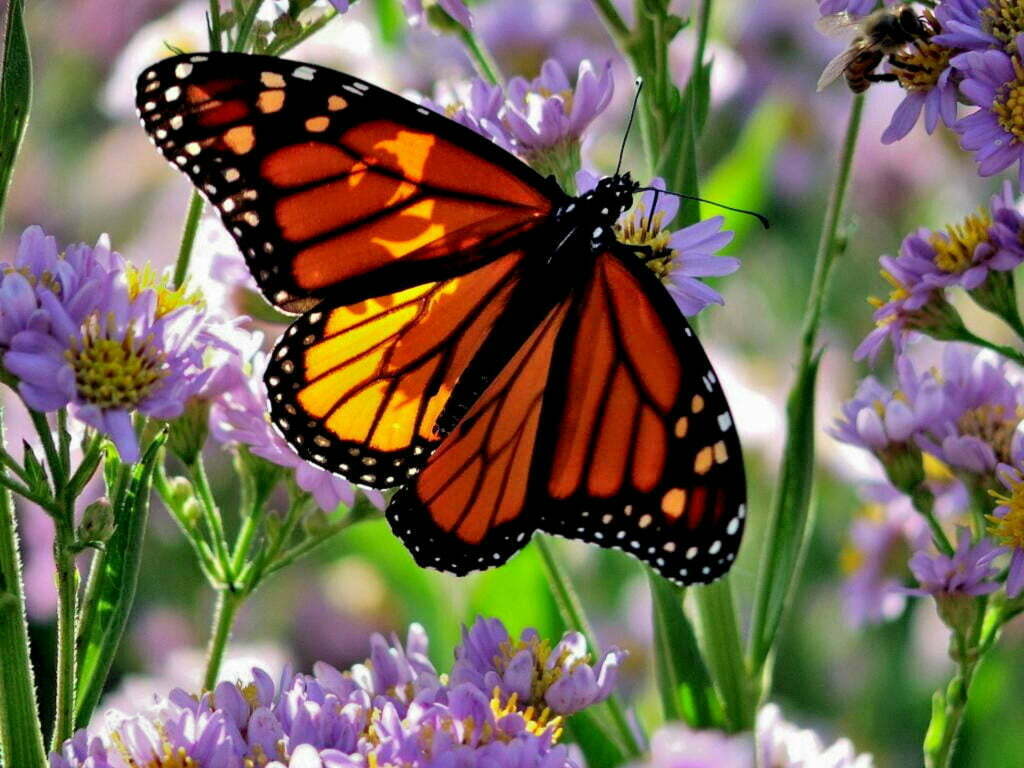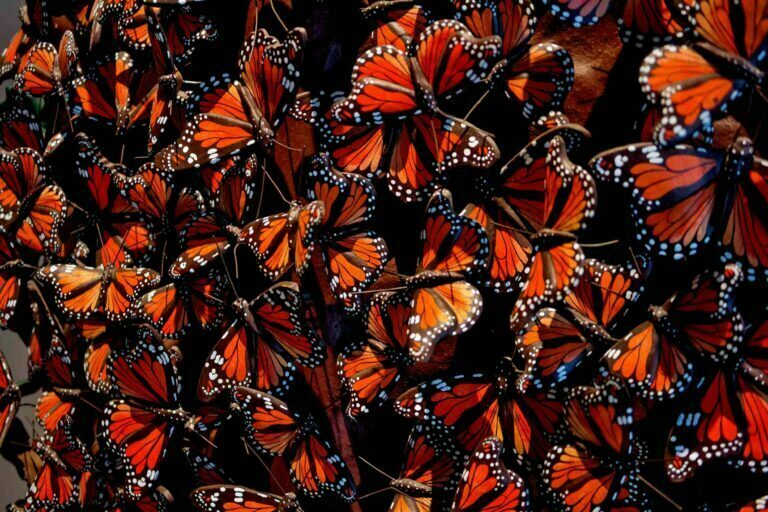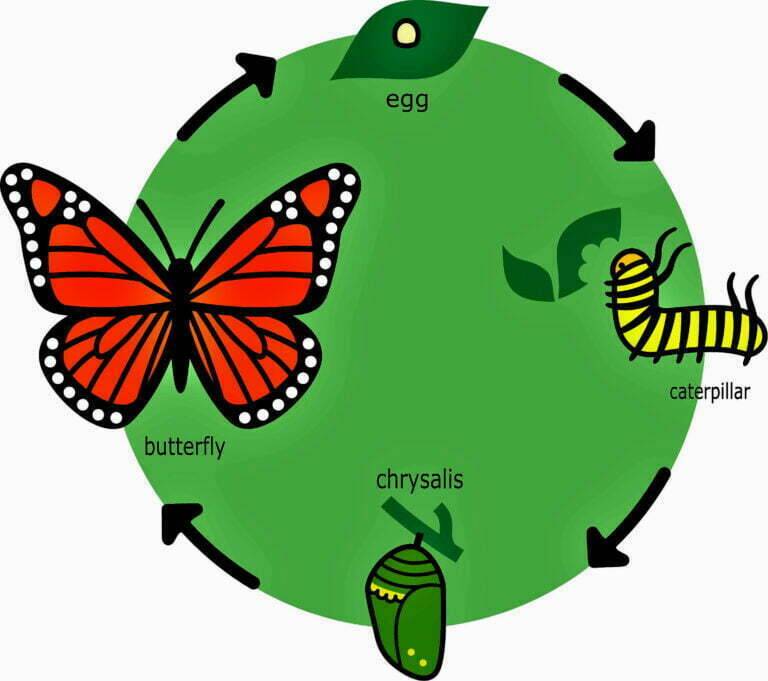Monarch butterflies are famous for their enormous size, orange and black wings, and long yearly migrations. Danaus Plexippus, also known as the monarch butterfly, is a well-known member of the milkweed butterfly family in the Lepidoptera order’s Danainae subfamily.
Monarch Butterfly Information
Monarchs are mostly found in North, Central, and South America, although they are also occasionally seen in Australia, Hawaii, India, and other places. There are several monarch subspecies identified.
The migratory Monarch butterflies, Danaus Plexippus Plexippus, can occasionally be spotted on Caribbean islands and is primarily found in North America. The “Danaus Plexippus Megalippe” non-migratory subspecies is found in the Cayman Islands of the Caribbean.
Monarch Butterfly Details
The wingspan of a monarch is typically 90 to 100 mm, or 4 inches. Predators are alerted to the insect’s repulsive taste by the orange hue of the wings, which are distinguished by black veins and a border with two rows of dots.
Monarch butterflies and viceroy butterflies (see brush-footed butterfly) have similar coloring. In fact, some of its predators find the viceroy unpleasant, much like the king.
As a result, it is thought that the two toxic species resemble one another to ward off predators, and their association serves as an illustration of Mullerian mimicry.
Monarch Butterfly Migration
Thousands of monarch butterflies from North America congregate in the autumn and migrate south, sometimes flying approximately 3,000 kilometers, or 1,800 miles,
The Monarch butterfly migration happens to spend the winter on the coast of California or in the Mexican mountains in the oyamel fir forest. In the spring, the monarch butterflies start to migrate back north while consuming nectar.
Monarch Butterfly’s life cycle
Monarch butterflies interact with scents and colors, as the males attract females to mate by releasing chemicals from scent glands on their hind wings.
Only milkweed plants are used for egg laying, and each new generation travels north after hatching and maturing.
Monarch Butterfly Caterpillar
The monarch butterfly caterpillar may be easily identified because of its distinctive vertical stripes in black, white, and yellow-green bands.
The Monarch caterpillar often moves away from its milkweed plant to pupate somewhere as a light-green chrysalis with golden spots.
Before metamorphosis, the Monarch caterpillar grows to a length of 45 mm, or about 2 inches, after going through multiple moults.
How long do Monarch Butterflies live
Adults monarch butterflies survive just a few weeks, unless they fly south and spend the winter in Mexico, where they might live for seven to nine months. Thus, there are around four monarchical generations per year.
Studies of several monarch populations in North and Central America, as well as on a few islands, have shown that there are variations in wing and body shape that are related to migratory patterns and breeding behavior.
For instance, long-distance migrant monarch populations in eastern North America have huge bodies and broad, angular forewings.
The bodies and forewings of non-migratory monarchs, which are found in Puerto Rico, southern Florida, Costa Rica, and Hawaii, are smaller.
Western North American monarchs have tiny bodies and wide wings, an adaptation that researchers think may be related to a preference for gliding flight.
Monarch Butterfly Life Span
Monarchs have developed in response to a variety of variables, including migratory effects, genetic drift, and breeding behavior. Research has revealed that the numerous body features and wing properties of monarchs are inherited.
The Monarch Butterfly Biosphere Reserve, a UNESCO World Heritage Site in Mexico, protects the monarch’s wintering woodlands.
Despite the fact that logging is prohibited there, illicit logging and forest degradation have put monarch populations in danger of extinction.
The monarch butterfly’s capacity to successfully complete its yearly migration feat is also seriously threatened by the continuing land development in regions along its various migration routes.
Further endangering the monarch’s long-term existence, according to some researchers, is the disappearance of milkweed plants brought on by the increase in the usage of genetically engineered herbicide-resistant crops in the United States in the early 21st century.
Despite the numerous dangers, there is little proof that monarch numbers are declining. The inability of scientists to effectively monitor populations and their inadequate understanding of naturally occurring regional and yearly population swings have made it difficult for them to assess the monarch’s population status.
Monarch Butterfly Facts for Kids
How informed are you about monarch butterflies? The following points will help you to memorize monarch butterfly details. Let’s know the Monarch butterfly facts.
- The milkweed leaves that the adult female monarch butterfly places her small, sticky-coated eggs on are poisonous milkweed leaves. A few days after the egg hatches, the caterpillar emerges and lives on the milkweed leaves.
- The poison from the milkweed plants is retained in the bodies of the monarch caterpillar and adult butterfly, preventing predators from consuming them.
- Adult monarch butterflies travel between 2,000 and 3,000 miles each way every spring to and from their winter haven in the southern woods of Mexico and California.
- The monarch butterfly will carry on feeding, flying, and reproducing for numerous generations all throughout the United States and southern Canada. When monarch butterflies migrate to Mexico in the fall, it is really the fourth generation that does so.
- Monarch butterflies may travel up to 100 miles per day throughout their 3,000-mile trek south.
- Each butterfly uses the substantial amount of food it consumed as a caterpillar as fuel for its trip.
- Monarchs’ antennae are used for scent. Their legs and feet have sensory hairs that can taste water and nectar.
- The Monarch butterfly only survives for 2 to 6 weeks after it has hatched.
- Since monarch butterflies are unable to bite, they ingest nectar using a long tongue known as a proboscis, which functions as an eyedropper.
- The tongue of this species coils up beneath the lower lip when not in use, resembling a retractable garden hose.
- Predators are warned by the monarch butterfly’s vivid hues that they should attack at their own peril, since the butterfly is toxic.
- Due to the presence of cardenolides, a kind of steroid, which the caterpillars get from the milkweed they feed on, monarchs are dangerous in addition to having a foul taste.
What Is The Monarch Butterfly Known For In Folklore?
Folklore claims that one of the 20 indicators of a harsh winter is the “early migration of the Monarch butterfly”!
What Can We Do to Promote the Survival of the Monarch Butterfly?
Sadly, monarch butterflies are in danger of disappearing. The National Wildlife Federation, the National Fish and Wildlife Foundation, and the U.S. Fish and Wildlife Service are collaborating to produce milkweed and other butterfly-friendly plants along the monarch butterfly’s primary migration route from Minnesota to Mexico in an effort to rescue them.
We can assist as well. In this manner:
- Plant a wildflower garden in your yard to attract pollinators like the honey bee and monarch butterfly.
-
Request that your local government and gardening groups collaborate to create pollinator wildflower gardens in municipal parks and other public spaces.
-
Plant milkweed in a field or your backyard.
-
Plant native wildflowers around your fence and driveway.
-
Inspire nearby farmers to set aside areas in ditches and between fence rows so that natural wildflowers can flourish without the use of chemical pesticides.
-
Avoid using chemical herbicides on your fields, lawn, or garden.
-
Get in touch with your local electric authority, complain, and seek to be included on the no-spray list if they spray chemical herbicides below power lines on your property.
-
Get a butterfly kit. Encourage your kids to see and understand the butterfly’s life cycle firsthand.
-
Please report any monarch sightings here.
Share to stand out from the crowd with this Blog.




